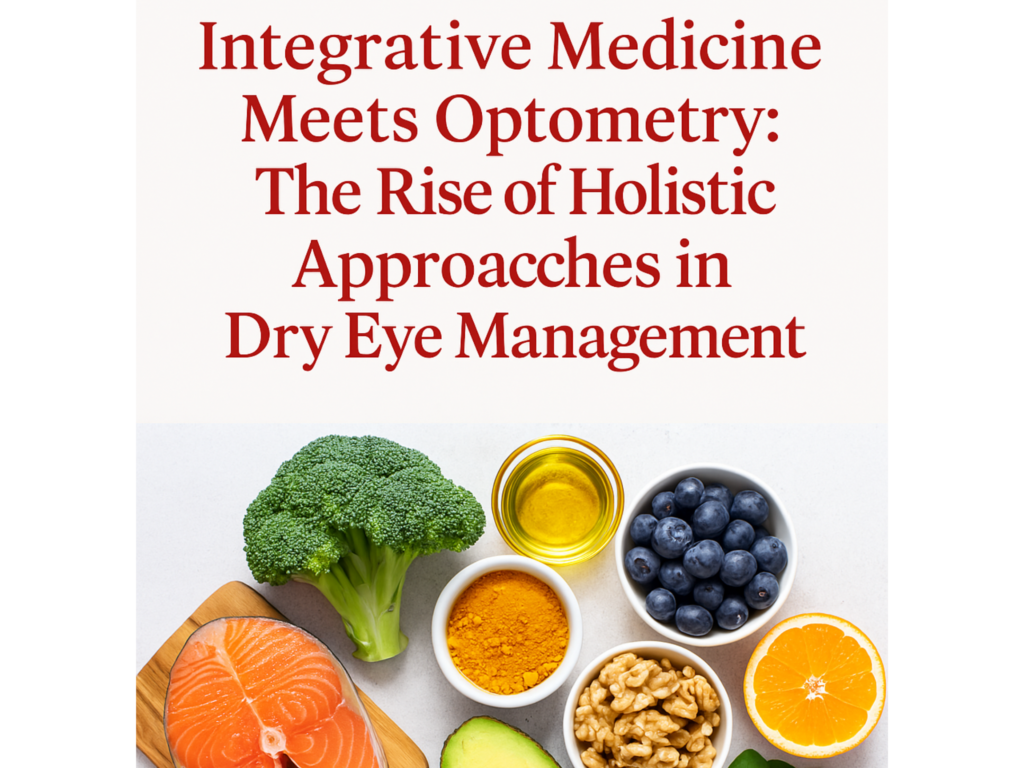Integrative Medicine Meets Optometry: The Rise of Holistic Approaches in Dry Eye Management

Dry Eye Disease (DED) remains one of the most frustrating chronic conditions we manage as optometrists. But what’s becoming increasingly clear in 2025 is this: patients want more than artificial tears and short-term relief. They want answers—and a care plan that treats the whole person, not just the ocular surface.
That’s where integrative medicine comes in. This growing care model blends conventional eye care with personalized wellness strategies including nutrition, stress reduction, and systemic support. It’s no longer “alternative.” It’s the evolution of comprehensive optometric care.
And at the heart of this shift? The body’s natural ability to heal—when supported with intention.
What Is Integrative Medicine in Eye Care?
Integrative medicine is a patient-centered, evidence-informed approach that combines conventional care with lifestyle-based practices to address root causes. In optometry, that means we can enhance dry eye treatment outcomes by incorporating nutrition, gut health, hormonal balance, and nervous system support.
And one of the simplest frameworks to build this into your patient care comes from Dr. Lauretta’s 4 Pillars of Wellness, which guide the full-body foundation for ocular and systemic health:
Dr. Lauretta’s 4 Pillars of Wellness
- Sleep – 6 to 8 hours of deep, restorative sleep each night
- Hydration – Drink half your body weight in ounces of hydrating fluids per day
- Nutrition – Eat bioindividual foods that support your unique body chemistry
- Elimination – Support daily detox through urination, bowel movements, and sweating
When one or more of these pillars is out of balance, dry eye symptoms can worsen. These fundamentals are not just “healthy living tips”—they are the baseline for effective, sustainable dry eye care.
Key Trends to Watch in 2025
1. Omega-3s and Anti-Inflammatory Diets
Omega-3 supplementation is no longer a fringe recommendation—it’s becoming standard in dry eye protocols. These fatty acids (especially EPA and DHA) are shown to reduce inflammation, improve meibomian gland function, and support tear quality. But beyond supplements, patients are seeing meaningful improvements by adopting anti-inflammatory diets rich in whole foods, leafy greens, and essential fats.
How to integrate:
- Include omega-3 questions in your intake forms
- Recommend a “Dry Eye Diet” handout with anti-inflammatory foods
- Partner with a registered dietitian to support patient-specific nutrition plans
This supports Pillar 3: Nutrition—guiding patients to eat foods that reduce inflammation and enhance systemic balance. Click HERE to download our Dry Eye Diet.
2. The Gut-Eye Connection
The research around gut health and ocular inflammation is accelerating. An imbalanced gut microbiome can trigger low-grade systemic inflammation, which is now believed to play a role in autoimmune-related dry eye, including conditions like Sjögren’s.
What you can do:
- Ask about GI symptoms in patients with chronic or treatment-resistant dry eye
- Consider referrals to functional medicine or GI specialists when appropriate
- Encourage foods that support gut lining and microbiota, such as prebiotics and fermented foods
Supporting gut health also reinforces Pillar 4: Elimination, by helping the body properly remove toxins and maintain balanced inflammation.
3. Stress Management and Nervous System Health
More clinicians are recognizing the connection between chronic stress and dry eye progression. Elevated cortisol levels impact hormone balance, immune function, and even tear secretion. Practices that support parasympathetic nervous system activation—like breathwork, meditation, or gentle movement—can help reduce these stress-related effects.
Action steps:
- Offer patient-friendly tools like breathing exercises or guided meditation apps
- Recommend regular screen breaks, better lighting, and ergonomic positioning
- Talk about how stress impacts sleep, hormone regulation, and eye inflammation
This strengthens Pillar 1: Sleep and helps patients regulate stress in a way that protects ocular health long term.
4. Low-Level Light Therapy (LLLT)
Low-Level Light Therapy is now being used as a non-invasive treatment for MGD and periocular inflammation. By stimulating mitochondrial activity and circulation in the lid area, LLLT can improve meibomian gland function and reduce discomfort.
Why it fits:
It’s drug-free, painless, and can be combined with more traditional therapies. It aligns well with patients seeking more natural or adjunctive approaches and supports full recovery without over-reliance on drops.
5. Acupuncture and Traditional Chinese Medicine (TCM)
TCM sees dry eye as a manifestation of systemic imbalances—particularly involving hormonal shifts and energy blockages. Acupuncture has shown promise in improving tear production, reducing inflammation, and addressing deeper patterns, especially in menopausal women.
How to apply:
- Build a referral network that includes licensed acupuncturists
- Educate patients on how alternative therapies may complement conventional care
- Track changes in symptoms for patients receiving integrative therapies
This aligns with Pillar 2: Hydration, as acupuncture helps regulate bodily systems that affect fluid balance—including the tear film.
Your Takeaway as an OD
Integrative care doesn’t mean abandoning what works—it means enhancing it. By layering holistic strategies on top of proven clinical treatments, you’ll improve outcomes, deepen patient trust, and set your practice apart in a crowded market.
Start simple:
- Ask more lifestyle questions
- Offer a Dry Eye Diet handout
- Share a one-page “4 Pillars of Wellness” resource
- Create a referral list of complementary providers
Patients are ready for a new kind of eye care—one that sees the whole picture. And now, you have a framework to lead the way.
Integrative medicine isn’t a trend—it’s the new standard for empowered, effective optometric care.





